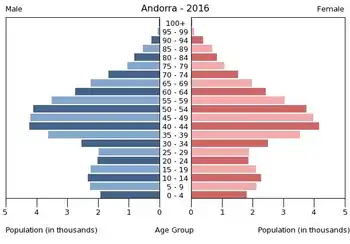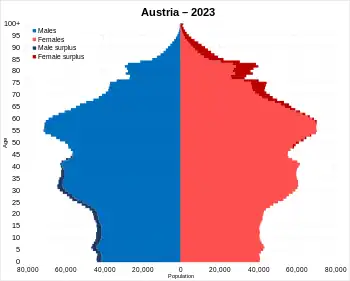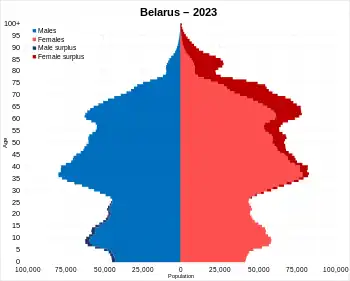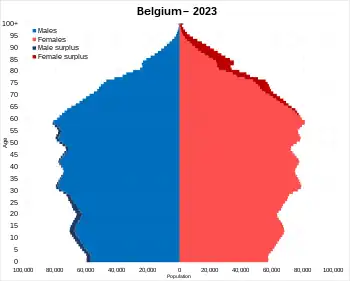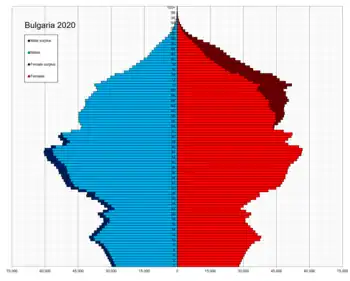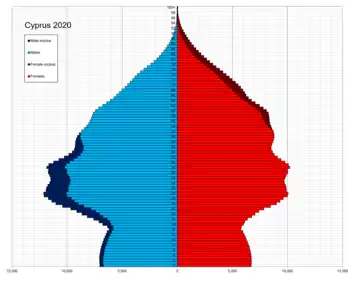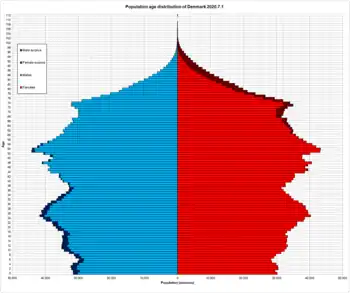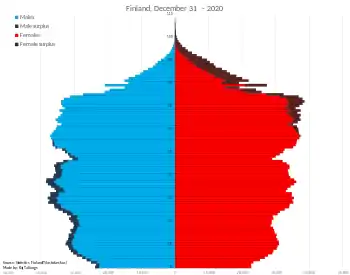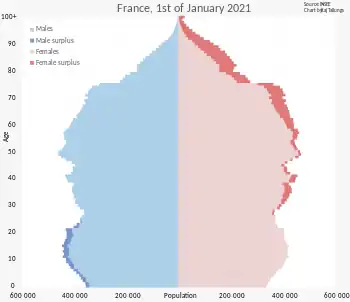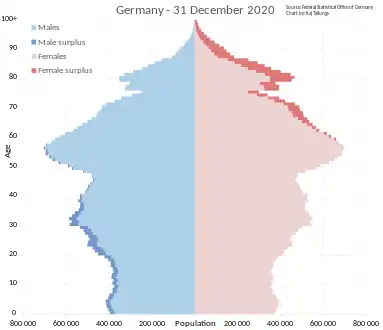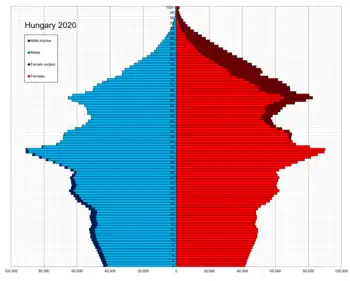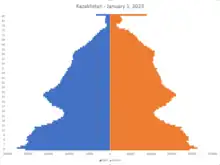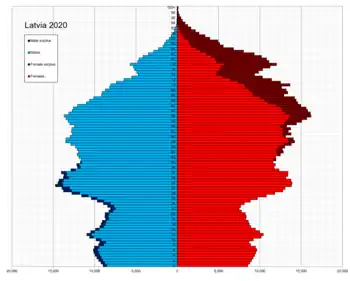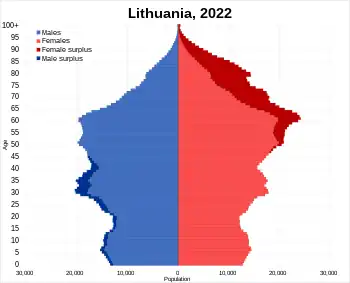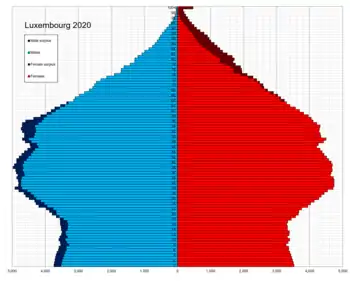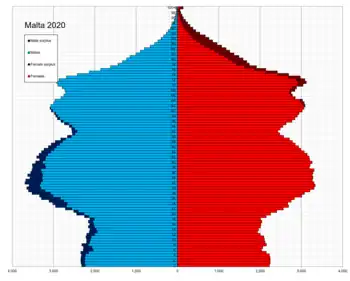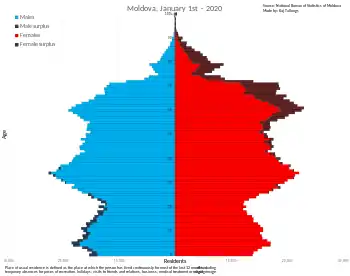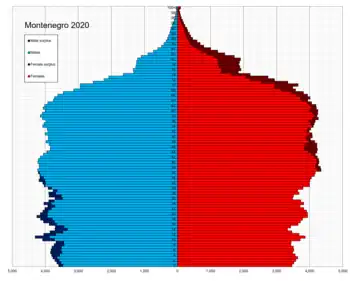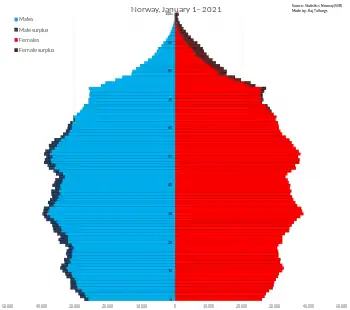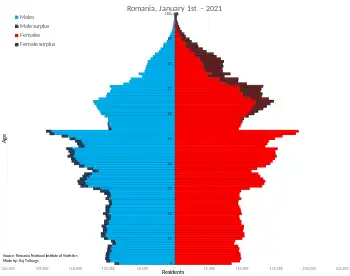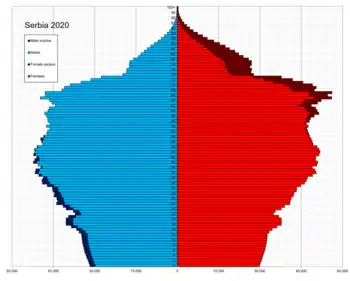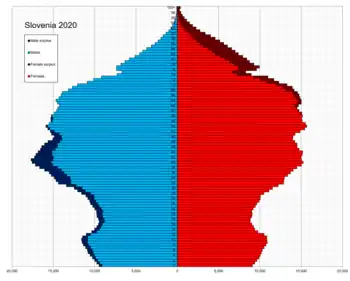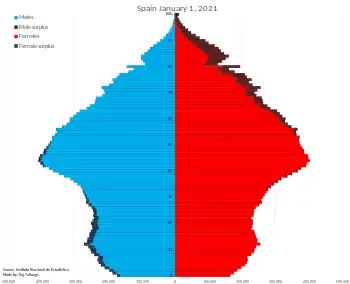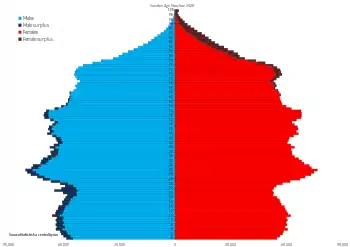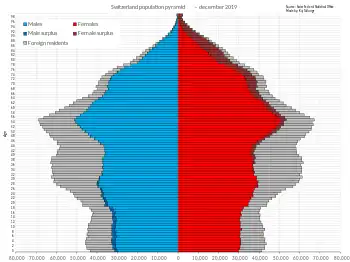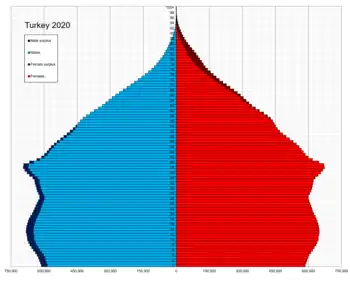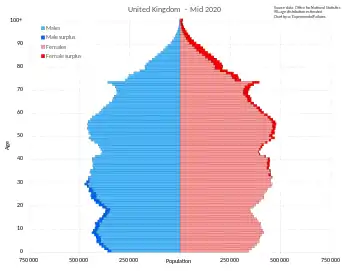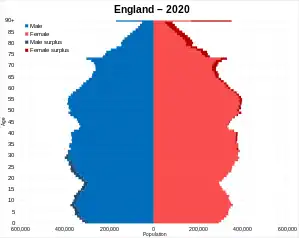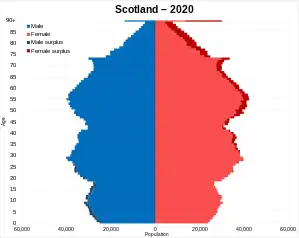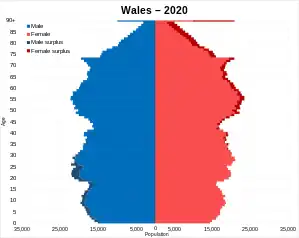.svg.png.webp)
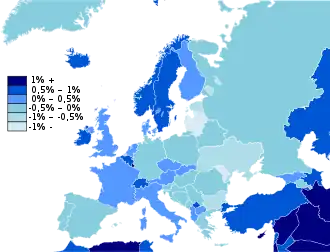
Figures for the population of Europe vary according to the particular definition of Europe's boundaries. In 2018, Europe had a total population of over 751 million people.[1][2] 448 million of that live in the European Union and 110 million live in European Russia, Russia being the most populous country in Europe.
Europe's population growth is low, and its median age high. Most of Europe is in a mode of sub-replacement fertility, which means that each new(-born) generation is less populous than the one before.[3] Nonetheless, most West European countries still have growing populations, mainly due to immigration within Europe and from outside Europe and some due to increases in life expectancy and population momentum. Some current and past factors in European demography have included emigration, ethnic relations, economic immigration, a declining birth rate and an ageing population.
History
Prehistory
According to Volker Heyd, an archaeologist at the University of Helsinki, up to 7 million people lived in Europe in 3000 BC.[4]
According to archaeologist Johannes Müller, European population was about 1 million around 6500 BCE which increased to 8 million in 2000 BCE.[5]
Estimates for historical population sizes of Europe (including Central Asia, listed under "former USSR") based on Maddison (2007),[6] in millions, with estimated percentage of world population:
| Year | Population (% of world total) |
|---|---|
| AD 1 | 34 (15%) |
| 1000 | 40 (15%) |
| 1500 | 78 (18%) |
| 1600 | 112 (20%) |
| 1700 | 127 (21%) |
| 1820 | 224 (21%) |
| 1913 | 498 (28%) |
| 2000 | 742 (13%) |
Past populations of Europe in modern national borders, AD 1–2020
| Country/region | 1 | 1000 | 1500 | 1600 | 1700 | 1820 | 1870 | 1913 | 1950 | 1973 | 1998 | 2020 |
|---|---|---|---|---|---|---|---|---|---|---|---|---|
| Austria | 500[7] | 700[7] | 2000[7] | 2500[7] | 2500[7] | 3369[7] | 4520[7] | 6767[7] | 6935[7] | 7586[7] | 8078[7] | 8901[7] |
| Belgium | 300[7] | 400[7] | 1400[7] | 1600[7] | 2000[7] | 3424[7] | 5096[7] | 7666[7] | 8640[7] | 9738[7] | 10197[7] | 11493[7] |
| Denmark | 180[7] | 360[7] | 600[7] | 650[7] | 700[7] | 1155[7] | 1888[7] | 2983[7] | 4269[7] | 5022[7] | 5303[7] | 5823[7] |
| Finland | 20[7] | 40[7] | 300[7] | 400[7] | 400[7] | 1169[7] | 1754[7] | 3027[7] | 4009[7] | 4666[7] | 5153[7] | 5536[7] |
| France | 5000[7] | 6500[7] | 15000[7] | 18500[7] | 21471[7] | 31246[7] | 38440[7] | 41463[7] | 41836[7] | 52118[7] | 58805[7] | 67287[7] |
| Germany | 3000[7] | 3500[7] | 12000[7] | 16000[7] | 15000[7] | 24905[7] | 39231[7] | 65058[7] | 68371[7] | 78956[7] | 82029[7] | 83191[7] |
| Italy | 7000[7] | 5000[7] | 10500[7] | 13100[7] | 13300[7] | 20176[7] | 27888[7] | 37248[7] | 47105[7] | 54751[7] | 57592[7] | 59258[7] |
| Netherlands | 200[7] | 300[7] | 950[7] | 1500[7] | 1900[7] | 2355[7] | 3615[7] | 6164[7] | 10114[7] | 13438[7] | 15700[7] | 17425[7] |
| Norway | 100[7] | 200[7] | 300[7] | 400[7] | 500[7] | 970[7] | 1735[7] | 2447[7] | 3265[7] | 3961[7] | 4432[7] | 5368[7] |
| Sweden | 200[7] | 400[7] | 550[7] | 760[7] | 1260[7] | 2585[7] | 4164[7] | 5621[7] | 7015[7] | 8137[7] | 8851[7] | 10379[7] |
| Switzerland | 300[7] | 300[7] | 650[7] | 1000[7] | 1200[7] | 1829[7] | 2664[7] | 3864[7] | 4694[7] | 6441[7] | 7130[7] | 8667[7] |
| United Kingdom | 800[7] | 2000[7] | 3942[7] | 6170[7] | 8565[7] | 21226[7] | 31393[7] | 45649[7] | 50363[7] | 56223[7] | 59237[7] | 67886[7] |
| Portugal | 500[7] | 600[7] | 1000[7] | 1100[7] | 2000[7] | 3297[7] | 4353[7] | 6004[7] | 8512[7] | 8634[7] | 9968[7] | 10305[7] |
| Spain | 4500[7] | 4000[7] | 6800[7] | 8240[7] | 8770[7] | 12203[7] | 16201[7] | 20263[7] | 27868[7] | 34810[7] | 39371[7] | 47431[7] |
| Greece | 2000[7] | 1000[7] | 1000[7] | 1500[7] | 1500[7] | 2312[7] | 7554[7] | 8929[7] | 10835[7] | 10689[7] | ||
| 13 small countries | 100[7] | 113[7] | 276[7] | 358[7] | 394[7] | 657[7] | ||||||
| Total Western Europe | 24700[7] | 25413[7] | 57268[7] | 73778[7] | 81460[7] | 132888[7] | 187532[7] | 261007[7] | 305060[7] | 358390[7] | 388399[7] | 419639[7] |
| Albania | 200[7] | 200[7] | 200[7] | 200[7] | 300[7] | 437 | 1215[7] | 2296[7] | 3108[7] | 2878[7] | ||
| Bulgaria | 500[7] | 800[7] | 800[7] | 1250[7] | 1250[7] | 2187[7] | 4200[7] | 7251[7] | 8621[7] | 8257[7] | 6917[7] | |
| Czechoslovakia | 1000[7] | 1250[7] | 3000[7] | 4500[7] | 4500[7] | 7190[7] | 12393[7] | 14563[7] | 15686[7] | 16366[7] | ||
| - Czech Rep. | 10221[7] | 8930[7] | 10295[7] | 10702[7] | ||||||||
| - Slovakia | 3463[7] | 4642[7] | 5391[7] | 5460[7] | ||||||||
| Hungary | 300[7] | 500[7] | 1250[7] | 1250[7] | 1500[7] | 4571[7] | 9338[7] | 10432[7] | 10237[7] | 9770[7] | ||
| Poland | 450[7] | 1200[7] | 4000[7] | 5000[7] | 6000[7] | 10426[7] | 25753[7] | 33363[7] | 38666[7] | 38268[7] | ||
| Romania | 800[7] | 800[7] | 2000[7] | 2000[7] | 2500[7] | 6389[7] | 7360[7] | 16311[7] | 20828[7] | 22503[7] | 19266[7] | |
| Yugoslavia | 1500[7] | 1750[7] | 2250[7] | 2750[7] | 2750[7] | 5215[7] | 16578[7] | 21088[7] | ||||
| Eastern Europe | 4750[7] | 6500[7] | 13500[7] | 16950[7] | 18800[7] | 36415[7] | 52182[7] | 79604[7] | 139428[7] | 173037[7] | 164513[7] | 151529[7] |
| Former USSR | 3900[7] | 7100[7] | 16950[7] | 20700[7] | 26550[7] | 54765[7] | 88672[7] | 156192[7] | 180050[7] | 249748[7] | 290866[7] | 299173[7] |
| - Russia | 102833[7] | 132434[7] | 147671[7] | 146171[7] | ||||||||
| - Ukraine | 31142[7] | 36905[7] | 48274[7] | 50370[7] | 41902[7] | |||||||
| World | 230820[7] | 268273[7] | 437818[7] | 555828[7] | 603410[7] | 1041092[7] | 1270014[7] | 1791020[7] | 2524531[7] | 3913482[7] | 5907680[7] | 7800000[7] |
| Country/region | 1 | 1000 | 1500 | 1600 | 1700 | 1820 | 1870 | 1913 | 1950 | 1973 | 1998 | 2018 |
|---|---|---|---|---|---|---|---|---|---|---|---|---|
| Austria | 0.2[7] | 0.3[7] | 0.5[7] | 0.4[7] | 0.4[7] | 0.3[7] | 0.4[7] | 0.4[7] | 0.3[7] | 0.2[7] | 0.1[7] | |
| Belgium | 0.1[7] | 0.1[7] | 0.3[7] | 0.3[7] | 0.3[7] | 0.3[7] | 0.4[7] | 0.4[7] | 0.3[7] | 0.2[7] | 0.2[7] | |
| Denmark | 0.1[7] | 0.1[7] | 0.1[7] | 0.1[7] | 0.1[7] | 0.1[7] | 0.1[7] | 0.2[7] | 0.2[7] | 0.1[7] | 0.1[7] | |
| Finland | 0.0[7] | 0.0[7] | 0.1[7] | 0.1[7] | 0.1[7] | 0.1[7] | 0.1[7] | 0.2[7] | 0.2[7] | 0.1[7] | 0.1[7] | |
| France | 2.2[7] | 2.4[7] | 3.4[7] | 3.3[7] | 3.6[7] | 3.0[7] | 3.0[7] | 2.3[7] | 1.7[7] | 1.3[7] | 1.0[7] | |
| Germany | 1.3[7] | 1.3[7] | 2.7[7] | 2.9[7] | 2.5[7] | 2.4[7] | 3.1[7] | 3.6[7] | 2.7[7] | 2.0[7] | 1.4[7] | |
| Italy | 3.0[7] | 1.9[7] | 2.4[7] | 2.4[7] | 2.2[7] | 1.9[7] | 2.2[7] | 2.1[7] | 1.9[7] | 1.4[7] | 1.0[7] | |
| Netherlands | 0.1[7] | 0.1[7] | 0.2[7] | 0.3[7] | 0.3[7] | 0.2[7] | 0.3[7] | 0.3[7] | 0.4[7] | 0.3[7] | 0.3[7] | |
| Norway | 0.0[7] | 0.1[7] | 0.1[7] | 0.1[7] | 0.1[7] | 0.1[7] | 0.1[7] | 0.1[7] | 0.1[7] | 0.1[7] | 0.1[7] | |
| Sweden | 0.1[7] | 0.1[7] | 0.1[7] | 0.1[7] | 0.2[7] | 0.2[7] | 0.3[7] | 0.3[7] | 0.3[7] | 0.2[7] | 0.1[7] | |
| Switzerland | 0.1[7] | 0.1[7] | 0.1[7] | 0.2[7] | 0.2[7] | 0.2[7] | 0.2[7] | 0.2[7] | 0.2[7] | 0.2[7] | 0.1[7] | |
| United Kingdom | 0.3[7] | 0.7[7] | 0.9[7] | 1.1[7] | 1.4[7] | 2.0[7] | 2.5[7] | 2.5[7] | 2.0[7] | 1.4[7] | 1.0[7] | |
| Portugal | 0.2[7] | 0.2[7] | 0.2[7] | 0.2[7] | 0.3[7] | 0.3[7] | 0.3[7] | 0.3[7] | 0.3[7] | 0.2[7] | 0.2[7] | |
| Spain | 1.9[7] | 1.5[7] | 1.6[7] | 1.5[7] | 1.5[7] | 1.2[7] | 1.3[7] | 1.1[7] | 1.1[7] | 0.9[7] | 0.7[7] | |
| Other | 0.9[7] | 0.4[7] | 0.3[7] | 0.3[7] | 0.3[7] | 0.3[7] | 0.4[7] | 0.4[7] | 0.5[7] | 0.4[7] | 0.3[7] | |
| Total Western Europe | 10.7[7] | 9.5[7] | 13.1[7] | 13.3[7] | 13.5[7] | 12.8[7] | 14.8[7] | 14.6[7] | 12.1[7] | 9.2[7] | 6.6[7] | |
| Eastern Europe | 2.1[7] | 2.4[7] | 3.1[7] | 3.0[7] | 3.1[7] | 3.5[7] | 4.1[7] | 4.4[7] | 3.5[7] | 2.8[7] | 2.0[7] | |
| Former USSR | 1.7[7] | 2.6[7] | 3.9[7] | 3.7[7] | 4.4[7] | 5.3[7] | 7.0[7] | 8.7[7] | 7.1[7] | 6.4[7] | 4.9[7] | |
| Total Europe | 14.5[7] | 14.5[7] | 20.1[7] | 20.0[7] | 21.0[7] | 21.6[7] | 25.9[7] | 27.7[7] | 22.7[7] | 18.4[7] | 13.5[7] | 9.8[8] |
| World | 100.0[7] | 100.0[7] | 100.0[7] | 100.0[7] | 100.0[7] | 100.0[7] | 100.0[7] | 100.0[7] | 100.0[7] | 100.0[7] | 100.0[7] | 100.0[7] |
- Note: These numbers do not include the population of European countries' colonies. Only population within Europe.
Total population


330,000,000 people lived in Europe in 1916.[9] In 1950 there were 549,000,000.[10] The population of Europe in 2015 was estimated to be 741 million according to the United Nations,[10] which was slightly less than 11% of the world population. The precise figure depends on the exact definition of the geographic extent of Europe. The population of the European Union (EU) was 509 million as of 2015.[11] Non-EU countries situated in Europe in their entirety[12] account for another 90 million. Five transcontinental countries[13] have a total of 247 million people, of which about half reside in Europe proper.
As it stands now, around 10% of the world's people live in Europe. If demographic trends keep their pace, its share may fall to around 7% in 2050, but still amounting to 716 million people in absolute numbers, according to the United Nations estimate.[10] (The decline in the percentage is partly due to high fertility rates in Africa and South America.) The sub-replacement fertility and high life expectancy in most European states mean a declining and aging population. High immigration and emigration levels within and from outside the continent are taking place and quickly changing countries, specifically in Western Europe, from a single ethnic group to a multicultural society. These trends change societies' economies as well as their political and social institutions.
Vital statistics
| Year | Average population |
Live births | Deaths | Natural change |
Crude rates (per 1000) | Total fertility rate |
Life expectancy | |||
|---|---|---|---|---|---|---|---|---|---|---|
| Births | Deaths | Natural change |
Migration change | |||||||
| 1950 | 549,721,718 | 12,202,220 | 6,473,233 | 5,728,987 | 22.2 | 11.8 | 10.4 | -1.6 | 2.70 | 62.8 |
| 1951 | 554,559,502 | 12,112,425 | 6,609,794 | 5,502,631 | 21.8 | 11.9 | 9.9 | -0.8 | 2.66 | 62.8 |
| 1952 | 559,609,904 | 12,142,368 | 6,265,135 | 5,877,233 | 21.7 | 11.2 | 10.5 | -0.8 | 2.66 | 64.0 |
| 1953 | 565,058,633 | 12,120,826 | 6,220,937 | 5,899,889 | 21.5 | 11.0 | 10.4 | -0.5 | 2.64 | 64.7 |
| 1954 | 570,670,994 | 12,151,779 | 6,072,645 | 6,079,134 | 21.3 | 10.6 | 10.7 | -0.8 | 2.64 | 65.5 |
| 1955 | 576,304,974 | 12,134,270 | 5,987,151 | 6,147,119 | 21.1 | 10.4 | 10.7 | -0.9 | 2.63 | 66.0 |
| 1956 | 581,975,516 | 12,133,583 | 5,899,594 | 6,233,989 | 20.8 | 10.1 | 10.7 | -0.8 | 2.62 | 66.9 |
| 1957 | 587,711,635 | 12,194,100 | 5,963,269 | 6,230,831 | 20.7 | 10.1 | 10.6 | -0.5 | 2.62 | 66.9 |
| 1958 | 593,669,297 | 12,177,600 | 5,647,571 | 6,530,029 | 20.5 | 9.5 | 11.0 | -0.9 | 2.60 | 68.2 |
| 1959 | 599,684,870 | 12,178,245 | 5,816,056 | 6,362,189 | 20.3 | 9.7 | 10.6 | -0.7 | 2.60 | 68.1 |
| 1960 | 605,629,870 | 12,098,378 | 5,783,828 | 6,314,550 | 20.0 | 9.6 | 10.4 | -0.4 | 2.58 | 68.8 |
| 1961 | 611,711,020 | 11,990,399 | 5,749,292 | 6,241,107 | 19.6 | 9.4 | 10.2 | -0.5 | 2.56 | 69.1 |
| 1962 | 617,672,206 | 11,784,056 | 6,023,706 | 5,760,350 | 19.1 | 9.8 | 9.3 | -0.1 | 2.53 | 68.9 |
| 1963 | 623,335,994 | 11,654,646 | 6,031,219 | 5,623,427 | 18.7 | 9.7 | 9.0 | 0 | 2.52 | 69.2 |
| 1964 | 628,944,878 | 11,467,618 | 5,843,514 | 5,624,104 | 18.2 | 9.3 | 8.9 | -0.4 | 2.50 | 69.9 |
| 1965 | 634,267,606 | 11,141,596 | 6,058,752 | 5,082,844 | 17.6 | 9.6 | 8.0 | -0.1 | 2.45 | 69.8 |
| 1966 | 639,264,461 | 10,950,076 | 6,074,808 | 4,875,268 | 17.1 | 9.5 | 7.6 | 0 | 2.42 | 70.0 |
| 1967 | 644,114,436 | 10,969,039 | 6,204,646 | 4,764,393 | 17.0 | 9.6 | 7.4 | -0.4 | 2.42 | 70.0 |
| 1968 | 648,610,191 | 10,821,004 | 6,427,622 | 4,393,382 | 16.7 | 9.9 | 6.8 | -0.4 | 2.38 | 69.9 |
| 1969 | 652,740,596 | 10,685,498 | 6,652,543 | 4,032,955 | 16.4 | 10.2 | 6.2 | -0.4 | 2.33 | 69.6 |
| 1970 | 656,521,426 | 10,568,071 | 6,602,177 | 3,965,894 | 16.1 | 10.1 | 6.0 | 0 | 2.28 | 70.0 |
| 1971 | 660,476,010 | 10,662,541 | 6,675,051 | 3,987,490 | 16.1 | 10.1 | 6.0 | 0.5 | 2.27 | 70.1 |
| 1972 | 664,799,679 | 10,499,844 | 6,699,913 | 3,799,931 | 15.8 | 10.1 | 5.7 | 0.5 | 2.21 | 70.3 |
| 1973 | 668,909,022 | 10,322,172 | 6,814,598 | 3,507,574 | 15.4 | 10.2 | 5.2 | 0.8 | 2.14 | 70.4 |
| 1974 | 672,912,941 | 10,406,013 | 6,818,259 | 3,587,754 | 15.5 | 10.1 | 5.3 | 0.4 | 2.13 | 70.6 |
| 1975 | 676,770,845 | 10,285,047 | 7,009,188 | 3,275,859 | 15.2 | 10.4 | 4.8 | 0.5 | 2.07 | 70.5 |
| 1976 | 680,361,150 | 10,242,399 | 7,085,837 | 3,156,562 | 15.1 | 10.4 | 4.6 | 0.5 | 2.03 | 70.6 |
| 1977 | 683,848,710 | 10,171,264 | 7,039,667 | 3,131,597 | 14.9 | 10.3 | 4.6 | 0.2 | 1.99 | 70.9 |
| 1978 | 687,149,553 | 10,143,418 | 7,183,531 | 2,959,887 | 14.8 | 10.5 | 4.3 | 0.3 | 1.96 | 70.9 |
| 1979 | 690,287,705 | 10,159,933 | 7,268,744 | 2,891,189 | 14.7 | 10.5 | 4.2 | 0.4 | 1.95 | 71.0 |
| 1980 | 693,437,228 | 10,156,371 | 7,422,720 | 2,733,651 | 14.6 | 10.7 | 3.9 | 0.4 | 1.93 | 70.9 |
| 1981 | 696,429,190 | 10,053,030 | 7,404,116 | 2,648,914 | 14.4 | 10.6 | 3.8 | 0.2 | 1.89 | 71.2 |
| 1982 | 699,220,370 | 10,102,647 | 7,373,734 | 2,728,913 | 14.4 | 10.5 | 3.9 | 0.1 | 1.89 | 71.5 |
| 1983 | 702,014,774 | 10,078,184 | 7,562,097 | 2,516,087 | 14.4 | 10.8 | 3.6 | 0.4 | 1.87 | 71.5 |
| 1984 | 704,798,623 | 10,050,688 | 7,584,914 | 2,465,774 | 14.3 | 10.8 | 3.5 | 0.4 | 1.86 | 71.6 |
| 1985 | 707,516,287 | 9,969,920 | 7,702,883 | 2,267,037 | 14.1 | 10.9 | 3.2 | 0.9 | 1.84 | 71.7 |
| 1986 | 710,385,076 | 9,987,274 | 7,423,641 | 2,563,633 | 14.1 | 10.5 | 3.6 | 0.7 | 1.84 | 72.5 |
| 1987 | 713,465,338 | 9,966,304 | 7,407,417 | 2,558,887 | 14.0 | 10.4 | 3.6 | 0.6 | 1.84 | 72.7 |
| 1988 | 716,444,431 | 9,840,567 | 7,475,880 | 2,364,687 | 13.7 | 10.4 | 3.3 | 0.4 | 1.82 | 72.8 |
| 1989 | 719,107,883 | 9,495,117 | 7,527,904 | 1,967,213 | 13.2 | 10.5 | 2.7 | 0.6 | 1.76 | 72.9 |
| 1990 | 721,497,282 | 9,235,425 | 7,681,197 | 1,554,228 | 12.8 | 10.6 | 2.2 | 0.7 | 1.72 | 72.9 |
| 1991 | 723,602,898 | 8,888,909 | 7,796,555 | 1,092,354 | 12.3 | 10.8 | 1.5 | 0.8 | 1.66 | 72.9 |
| 1992 | 725,259,493 | 8,523,515 | 7,935,829 | 587,686 | 11.8 | 10.9 | 0.8 | 0.8 | 1.60 | 72.7 |
| 1993 | 726,441,892 | 8,138,793 | 8,412,609 | -273,816 | 11.2 | 11.6 | -0.4 | 1.4 | 1.53 | 72.1 |
| 1994 | 727,063,162 | 7,913,453 | 8,492,472 | -579,019 | 10.9 | 11.7 | -0.8 | 1.1 | 1.50 | 72.1 |
| 1995 | 727,300,408 | 7,663,831 | 8,553,348 | -889,517 | 10.5 | 11.8 | -1.2 | 1.4 | 1.46 | 72.2 |
| 1996 | 727,453,566 | 7,581,575 | 8,394,631 | -813,056 | 10.4 | 11.5 | -1.1 | 1.3 | 1.45 | 72.7 |
| 1997 | 727,566,480 | 7,476,674 | 8,240,385 | -763,711 | 10.3 | 11.3 | -1.0 | 0.8 | 1.43 | 73.2 |
| 1998 | 727,445,606 | 7,369,527 | 8,193,143 | -823,616 | 10.1 | 11.3 | -1.1 | 0.6 | 1.42 | 73.6 |
| 1999 | 727,100,016 | 7,264,382 | 8,402,774 | -1,138,392 | 10.0 | 11.6 | -1.6 | 1.4 | 1.40 | 73.4 |
| 2000 | 726,968,473 | 7,325,763 | 8,401,888 | -1,076,125 | 10.1 | 11.6 | -1.5 | 1.4 | 1.42 | 73.5 |
| 2001 | 726,878,371 | 7,277,594 | 8,364,598 | -1,087,004 | 10.0 | 11.5 | -1.5 | 1.6 | 1.41 | 73.8 |
| 2002 | 726,939,358 | 7,330,526 | 8,520,890 | -1,190,364 | 10.1 | 11.7 | -1.6 | 2.3 | 1.42 | 73.8 |
| 2003 | 727,424,988 | 7,442,475 | 8,655,471 | -1,212,996 | 10.2 | 11.9 | -1.7 | 2.7 | 1.45 | 73.8 |
| 2004 | 728,163,243 | 7,558,652 | 8,381,363 | -822,711 | 10.4 | 11.5 | -1.1 | 2.2 | 1.47 | 74.4 |
| 2005 | 728,950,486 | 7,568,637 | 8,494,391 | -925,754 | 10.4 | 11.7 | -1.3 | 2.5 | 1.47 | 74.5 |
| 2006 | 729,857,708 | 7,703,029 | 8,237,212 | -534,183 | 10.6 | 11.3 | -0.7 | 2.8 | 1.50 | 75.2 |
| 2007 | 731,393,136 | 7,886,129 | 8,187,820 | -301,691 | 10.8 | 11.2 | -0.4 | 2.9 | 1.54 | 75.6 |
| 2008 | 733,256,182 | 8,169,398 | 8,195,293 | -25,895 | 11.1 | 11.2 | 0.0 | 2.2 | 1.59 | 75.8 |
| 2009 | 734,902,805 | 8,208,268 | 8,099,043 | 109,225 | 11.2 | 11.0 | 0.1 | 1.8 | 1.60 | 76.3 |
| 2010 | 736,276,813 | 8,227,484 | 8,128,387 | 99,097 | 11.2 | 11.0 | 0.1 | 1.7 | 1.61 | 76.5 |
| 2011 | 737,589,666 | 8,132,980 | 7,958,960 | 174,020 | 11.0 | 10.8 | 0.2 | 1.6 | 1.60 | 77.1 |
| 2012 | 738,907,594 | 8,178,804 | 8,078,292 | 100,512 | 11.1 | 10.9 | 0.1 | 1.4 | 1.62 | 77.3 |
| 2013 | 740,013,806 | 8,039,791 | 8,033,963 | 5,828 | 10.9 | 10.9 | 0.0 | 1.4 | 1.60 | 77.6 |
| 2014 | 741,014,147 | 8,067,454 | 7,955,740 | 111,714 | 10.9 | 10.7 | 0.2 | 1.3 | 1.62 | 77.9 |
| 2015 | 742,107,449 | 8,004,465 | 8,177,599 | -173,134 | 10.8 | 11.0 | -0.2 | 1.8 | 1.62 | 78.0 |
| 2016 | 743,318,582 | 7,950,684 | 8,009,194 | -58,510 | 10.7 | 10.8 | -0.1 | 1.6 | 1.62 | 78.4 |
| 2017 | 744,449,361 | 7,617,755 | 8,076,159 | -458,404 | 10.2 | 10.8 | -0.6 | 1.8 | 1.56 | 78.7 |
| 2018 | 745,359,130 | 7,375,157 | 8,112,356 | -737,199 | 9.9 | 10.9 | -1.0 | 2.1 | 1.53 | 78.8 |
| 2019 | 746,189,645 | 7,108,392 | 8,020,246 | -911,854 | 9.5 | 10.7 | -1.2 | 1.2 | 1.49 | 79.1 |
| 2020 | 746,225,356 | 6,938,739 | 9,119,281 | -2,180,542 | 9.3 | 12.2 | -2.9 | 1.5 | 1.47 | 77.7 |
| 2021 | 745,173,774 | 6,879,818 | 9,656,398 | -2,776,580 | 9.2 | 13.0 | -3.7 | 1.48 | 77.0 | |
Population by country
.svg.png.webp)
According to different definitions, such as consideration of the concept of Central Europe, the following territories and regions may be subject to various other categorisations aside from geographic conventions.
| Country (or territory) | Population [1][2] |
Area (km2)[15] |
Density (per km2) |
|---|---|---|---|
| 2,854,710 | 28,748 | 99 | |
| 79,034 | 468 | 169 | |
| 2,790,974 | 29,743 | 94 | |
| 8,922,082 | 83,871 | 106 | |
| 10,312,992 | 86,600 | 119 | |
| 9,578,167 | 207,600 | 46 | |
| 11,611,419 | 30,528 | 380 | |
| 3,270,943 | 51,209 | 64 | |
| 6,520,314 | 110,900 | 59 | |
| 4,060,135 | 56,594 | 72 | |
| 1,244,188 | 9,251 | 134 | |
| 10,510,751 | 78,866 | 133 | |
| 5,854,240 | 43,094 | 136 | |
| 1,328,701 | 45,227 | 29 | |
| 49,709 | 1,399 | 35.6 | |
| 5,535,992 | 336,852 | 16 | |
| 64,531,444 | 551,500 | 117 | |
| 3,757,980 | 69,700 | 54 | |
| 83,408,554 | 357,137 | 234 | |
| 32,669 | 6 | 5,445 | |
| 10,445,365 | 131,957 | 79 | |
| 65,345 | 63 | 1,037 | |
| 9,709,786 | 93,026 | 104 | |
| 370,335 | 103,000 | 4 | |
| 4,986,526 | 69,825 | 71 | |
| 84,263 | 572 | 147 | |
| 59,240,329 | 301,339 | 197 | |
| 97,857 | 116 | 844 | |
| 1,859,203 | 10,887 | 171 | |
| 1,873,919 | 64,562 | 29 | |
| 39,039 | 160 | 244 | |
| 2,786,651 | 65,300 | 43 | |
| 639,321 | 2,586 | 247 | |
| 526,748 | 316 | 1,667 | |
| 3,061,506 | 33,846 | 90 | |
| 36,686 | 2 | 18,343 | |
| 627,859 | 13,812 | 45 | |
| 17,501,696 | 37,354 | 469 | |
| 2,103,330 | 25,713 | 82 | |
| 5,403,021 | 323,787 | 17 | |
| 38,307,726 | 311,888 | 123 | |
| 10,290,103 | 92,212 | 112 | |
| 19,328,560 | 238,391 | 81 | |
| 145,102,755 | 17,098,246 | 8 | |
| 33,745 | 61 | 553 | |
| 7,296,769 | 88,361 | 83 | |
| 5,447,622 | 49,036 | 111 | |
| 2,119,410 | 20,273 | 105 | |
| 47,486,935 | 505,992 | 94 | |
| 2,868 | 62,422 | 0 | |
| 10,467,097 | 450,295 | 23 | |
| 8,691,406 | 41,285 | 211 | |
| 505,000 | 4,163 | 121.3 | |
| 84,775,404 | 783,562 | 108 | |
| 43,531,422 | 603,500 | 72 | |
| 67,281,039 | 242,495 | 277 | |
| 842 | 0.4 | 1,913.6 | |
| 28,666 | 1,580 | 18 |
* indicates link goes to article on demographics of the country (or territory), not just the country itself.
Age

Mirroring their mostly sub-replacement fertility and high life expectancy, European countries tend to have older populations overall. They had nine of the top ten highest median ages in national populations in 2005. Only Japan had an older population.[16]
Fertility
According to Eurostat, the average birth rate in the European Union was 1.5 children per woman in 2020. The EU countries with the highest rates were France (1.83 live births per woman), Romania (1.80) and Czechia (1.71). The lowest rates were found in Malta (1.13), Spain (1.19) and Italy (1.24).[17]
The reasons that Italian citizens give for not having children are economic costs, fear of losing their jobs, and lack of services for families.[18]
Eurostat says that the proportion of children born to foreign mothers, including both from other EU member states and from non-EU countries, has been increasing in the EU since 2013 and stood at 21% in 2020.[17]
Religion
Over the last several centuries, religious practice has been on the decline in a process of secularization. Several European countries have experienced a decline in church attendance as well as a decline in the number of people professing a religious belief. The 2010 Eurobarometer survey found that, on average, 51% of the citizens of the European Union that they believe there is a God, 26% believe there is some sort of spirit or life force and 20% don't believe there is any sort of spirit, God or life force. 3% declined to answer.[19] The Eurobarometer survey must be taken with caution, however, as there are discrepancies between it and national census results. For example, in the United Kingdom, the 2001 census revealed that over 70% of the population regarded themselves as "Christians" with only 15% professing to have no religion, though the wording of the question has been criticized as "misleading" by the British Humanist Association.[20] The 2011 census showed a dramatic reduction to less than 60% of the population regarding themselves as "Christians".[21]
Despite its decline, Christianity is still the largest religion in Europe. According to a survey published in 2010, 76.2% of Europeans identified themselves as Christians.[22][23] Catholics were the largest Christian group in Europe, accounting for more than 48% of European Christians.[24] The second-largest Christian group in Europe was the Orthodox, who made up 32% of European Christians.[24] And about 19% of European Christians were part of the Protestant tradition. Europe constitutes in absolute terms the world's largest Christian population.[25] According to Scholars, in 2017, Europe's population was 77.8% Christian (up from 74.9% 1970),[26][27] these changes were largely result of the collapse of Communism and switching to Christianity in the former Soviet Union and Eastern Bloc countries.[26]
According to a 2003 study,[28] 47% of French people declared themselves as agnostics in 2003. This situation is often called "Post-Christian Europe". A decrease in religiousness and church attendance in western Europe (especially in Belgium, the Czech Republic, Finland, France, Germany, the United Kingdom, Norway, the Netherlands and Sweden) has been noted. According to a survey published in 2012, atheists and agnostics make up about 18.2% of the European population.[29] According to the same survey the religiously unaffiliated make up the majority of the population only in two European countries: Czech Republic (75%) and Estonia (60%).[29]
According to another survey about Religiosity in the European Union from 2012 by Eurobarometer, Christianity was the largest religion in the Union (accounting for 72% of the total population), Catholics were with 48% the largest Christian group in the Union, Protestants made up 12%, Eastern Orthodox made up 8% and other Christians accounted for 4% of the total population.[30] non-believers/agnostics accounted for 16%, atheists accounted for 7% and Muslims accounted for 2%.[31]
Ethnic groups
Pan and Pfeil (2004) count 87 distinct "peoples of Europe", of which 33 form the majority population in at least one sovereign state, while the remaining 54 constitute ethnic minorities. The total number of national minority populations in Europe is estimated at 105 million people, or 14% of 770 million Europeans. (including Europeans in Siberia)[32]
The largest ethnic groups are the Russians, with 117 million, and the Germans, with 72 million. In some countries such as the United Kingdom, France and Spain, the designation of nationality may controversially take on ethnic aspects, subsuming smaller ethnic groups such as Scots, Welsh, Cornish, Northern Irish, Bretons, Catalans, and Basques, making it difficult to quantify a "British" or "French" ethnicity, for example.
There are an estimated 10 million Romani people in Europe.[33]
Language
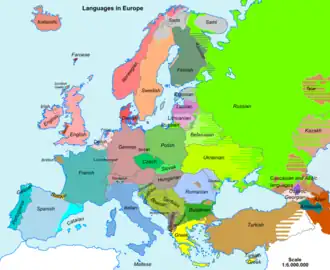
Most of the languages of Europe belong to the Indo-European language family. This family is divided into a number of branches, including Romance, Germanic, Baltic, Slavic, Albanian, Celtic, Armenian and Greek. The Uralic languages, which include Hungarian, Finnish, Estonian, Udmurt, Mordvin and Sami also have a significant presence in Europe. The Turkic family also has several European members, while the North Caucasian and Kartvelian families which include Georgian, Circassian, Chechen and Abkhaz anong others are important in the southeastern extremity of geographical Europe. The Basque language of the western Pyrenees is an isolate unrelated to any other group, while Maltese is the only Semitic language in Europe with national language status, although Arabic, Hebrew and Assyrian Neo-Aramaic/Syriac are spoken by migrant populations. The Kalmyk language, is an Mongolic language, spoken in Kalmykia, located directly north of the North Caucasus in Eastern Europe. The most spoken language of Europe is Russian, which belongs to the group of Slavic languages.
Languages that are not official state languages are protected in many European countries by the European Charter for Regional or Minority Languages. These can include languages spoken by relatively many people, such as Catalan and Basque in Spain, Frisian in the Netherlands, as well as languages spoken by relatively few such as Cornish Manx and Scottish Gaelic in the United Kingdom, and Romansch in Switzerland.
Genetic origins

Homo sapiens appeared in Europe roughly 40,000 years ago, with the settlement of the Cro-Magnons, followed by European hunter-gatherers and Early European Farmers (EEF). Over the prehistoric period there was continuous settlement in Europe, notably by the immediate descendants of the Proto-Indo-Europeans who migrated west after the advent of the Neolithic revolution.[35]
Mitochondrial DNA and Y-chromosome DNA
Studies of mitochondrial DNA (mtDNA) have suggested substantial genetic homogeneity of European populations,[36] with only a few geographic or linguistic isolates appearing to be genetic isolates as well.[37] On the other hand, analyses of the Y chromosome[38][39] and of autosomal diversity[40] have shown a general gradient of genetic similarity running from the southeast to the northwest of the continent.
Autosomal DNA
According to geneticist David Reich, based on ancient human genomes that his laboratory sequenced in 2016, Europeans formed from four West-Eurasian ancestral components in varying degrees: Western Hunter-Gatherers (WHG), Eastern Hunter-Gatherers (EHG), Neolithic Levant farmers and Neolithic Iranian farmers respectively.[42]
Population structure
A study in May 2009[43] that examined 19 populations from Europe using 270,000 single nucleotide polymorphisms (SNPs) highlighted the genetic diversity of European populations corresponding to the northwest to southeast gradient and distinguished "several distinct regions" within Europe:
- Finland
- the Baltic states (Estonia, Latvia and Lithuania), western Russia and Poland
- Central and Western Europe
- Italy, South-Eastern Europe, Southern Russia
In this study, Fst (fixation index) was found to correlate considerably with geographic distances ranging from ≤0.0010 for neighbouring populations to 0.0230 for Southern Italy and Finland. For comparisons, pair-wise Fst of non-European samples were as follows: Europeans – Yoruba (West Africans) 0.1530; Europeans – Chinese 0.1100; Yoruba (West Africans) – Chinese 0.1900.[43]: Table S2
See also
- Area and population of European countries
- Classical demography
- Demographics of the European Union
- Ethnic groups in Europe
- European diasporas
- European Union statistics
- Migration from Latin America to Europe
- List of cities in the European Union by population within city limits
- List of urban areas of the European Union
- List of European countries by population growth rate
- List of European countries by population
- List of metropolitan areas in Europe
- Medieval demography
- Demographics of the world
- List of countries by fertility rate
Notes
^ a: Continental regions as per UN categorisations/map. Depending on definitions, various territories cited below may be in one or both of Europe and Asia, or Africa.
^ b: Includes Transnistria, a region that has declared, and de facto achieved, independence; however, it is not recognised de jure by sovereign states.
^ c: Russia is considered a transcontinental country in Eastern Europe and Northern Asia. However, the population and area figures include the entire state.
^ d: Guernsey, the Isle of Man and Jersey are Crown Dependencies of the United Kingdom. Other Channel Islands in the Bailiwick of Guernsey include Alderney and Sark.
^ e: Cyprus is physiographically entirely in Western Asia, but it has strong historical and sociopolitical connections with Europe. The population and area figures refer to the entire state, including the de facto independent part Northern Cyprus.
^ f: Figures for Portugal include the Azores and Madeira archipelagos, both in Northern Atlantic.
^ g: Area figure for Serbia includes Kosovo, a province that unilaterally declared its independence from Serbia on 17 February 2008, and whose sovereign status is unclear. Population and density figures are 2010 estimates and are given without the disputed territory of Kosovo.
^ h: Figures for France include metropolitan France but not overseas departments and territories as they are not part of the European continent.
^ j: Kazakhstan is physiographically considered a transcontinental country in Central Asia (UN region) and Eastern Europe, with European territory west of the Ural Mountains and both the Ural and Emba rivers. However, area and population figures refer to the entire country.
^ k: Armenia is physiographically entirely in Western Asia, but it has strong historical and sociopolitical connections with Europe. The population and area figures include the entire state respectively.
^ m: Georgia is often considered a transcontinental country in Western Asia and Eastern Europe. However, the population and area figures include the entire state. This also includes Georgian estimates for Abkhazia and South Ossetia, two regions that have declared and de facto achieved independence. The International recognition, however, is limited.
^ o: The total figures for area and population includes the whole of the transcontinental countries. The precision of these figure is compromised by the ambiguous geographical extend of Europe and the lack of references for European portions of transcontinental countries.
^ p: Kosovo unilaterally declared its independence from Serbia on 17 February 2008. Its sovereign status is unclear. Its population is a 2007 estimate.
^ r: Abkhazia and South Ossetia unilaterally declared their independence from Georgia on 25 August 1990 and 28 November 1991 respectively. Their sovereign status is unclear. Population figures stated as of 2003 census and 2000 estimates respectively.
References
- 1 2 "World Population Prospects 2022". population.un.org. United Nations Department of Economic and Social Affairs, Population Division. Retrieved 17 July 2022.
- 1 2 "World Population Prospects 2022: Demographic indicators by region, subregion and country, annually for 1950-2100" (XSLX). population.un.org ("Total Population, as of 1 July (thousands)"). United Nations Department of Economic and Social Affairs, Population Division. Retrieved 17 July 2022.
- ↑ "Figure 8: Population by Total Fertility (millions)" in World Population Prospects, the 2010 Revision. United Nations, Department of Economic and Social Affairs, Population Division (2011)
- ↑ "The first Europeans weren't who you might think". National Geographic. August 2019. Archived from the original on 19 March 2021.
- ↑ Müller, Johannes (2015). "EIGHT MILLION NEOLITHIC EUROPEANS: SOCIAL DEMOGRAPHY AND SOCIAL ARCHAEOLOGY ON THE SCOPE OF CHANGE – FROM THE NEAR EAST TO SCANDINAVIA". Paradigm Found: Archaeological Theory – Present, Past and Future. Essays in Honour of Evžen Neustupný. Oxbow Books. ISBN 978-1-78297-770-4. Archived from the original on 3 January 2024.
- ↑ Angus Maddison, The World Economy: Historical Statistics, Statistical Appendix (2007, ggdc.net). Estimates cited are for the beginning of the 1st millennium ("year 0"), the beginning of the 2nd millennium ("year 1000"), and for the beginning each century since the 16th (years 1820 and 1913 are given for the 19th and 20th century, respectively, as Maddison presents detailed estimates for these years), and a projection for the year 2030.
- 1 2 3 4 5 6 7 8 9 10 11 12 13 14 15 16 17 18 19 20 21 22 23 24 25 26 27 28 29 30 31 32 33 34 35 36 37 38 39 40 41 42 43 44 45 46 47 48 49 50 51 52 53 54 55 56 57 58 59 60 61 62 63 64 65 66 67 68 69 70 71 72 73 74 75 76 77 78 79 80 81 82 83 84 85 86 87 88 89 90 91 92 93 94 95 96 97 98 99 100 101 102 103 104 105 106 107 108 109 110 111 112 113 114 115 116 117 118 119 120 121 122 123 124 125 126 127 128 129 130 131 132 133 134 135 136 137 138 139 140 141 142 143 144 145 146 147 148 149 150 151 152 153 154 155 156 157 158 159 160 161 162 163 164 165 166 167 168 169 170 171 172 173 174 175 176 177 178 179 180 181 182 183 184 185 186 187 188 189 190 191 192 193 194 195 196 197 198 199 200 201 202 203 204 205 206 207 208 209 210 211 212 213 214 215 216 217 218 219 220 221 222 223 224 225 226 227 228 229 230 231 232 233 234 235 236 237 238 239 240 241 242 243 244 245 246 247 248 249 250 251 252 253 254 255 256 257 258 259 260 261 262 263 264 265 266 267 268 269 270 271 272 273 274 275 276 277 278 279 280 281 282 283 284 285 286 287 288 289 290 291 292 293 294 295 296 297 298 299 300 301 302 303 304 305 306 307 308 309 310 311 312 313 314 315 316 317 318 319 320 321 322 323 324 325 326 327 328 329 330 331 332 333 334 335 336 337 338 339 340 341 342 343 344 345 346 347 348 349 350 351 352 353 354 355 356 357 358 359 360 361 362 363 364 365 366 367 368 369 370 371 372 373 374 375 376 377 378 379 380 381 382 383 384 385 386 387 388 389 390 391 392 393 394 395 396 397 398 399 400 401 402 403 404 405 406 407 408 409 410 411 412 413 414 415 416 417 418 419 420 421 422 423 424 425 426 427 428 429 430 431 432 433 434 435 436 437 438 439 440 441 442 443 444 445 446 447 448 449 450 451 452 453 454 455 456 457 458 459 460 461 462 463 464 465 466 467 468 469 470 471 472 473 474 475 476 477 478 479 480 481 482 483 484 485 486 487 488 489 490 491 492 493 494 495 496 497 498 499 500 501 502 503 504 505 506 507 508 509 510 511 512 513 514 515 516 517 518 519 520 521 522 523 524 525 526 527 528 529 530 531 532 533 534 535 536 537 538 539 Maddison. "Growth of World Population, GDP and GDP Per Capita before 1820" (PDF). Retrieved 27 July 2016.
- ↑ "Europe Population (LIVE)". worldometers.info.
- ↑ Charles Morris, ed. (1916). Winston's Cumulative ...: Encyclopedia; a Comprehensive Reference Book, Volume 4. John C. Winston Company. Retrieved 17 May 2014.
- 1 2 3 "World Population Prospects: The 2017 Revision". UN – Department of Economic and Social Affairs. Retrieved 27 January 2018.
- ↑ "Eurostat: Population on 1 January". European Commission. Retrieved 27 January 2018.
- ↑ Population in million: Albania 2.9, Belarus 9.5, Bosnia and Herzegovina 3.5, Iceland 0.3, Moldova 4.1, North Macedonia 2.1, Norway 5.2, Serbia and Kosovo 8.9, Switzerland 8.3, Ukraine 44.7.
- ↑ Population in million: Armenia 2.9, Georgia 4.0, Kazakhstan 17.8, Russia 144, Turkey 78.3.
- ↑ "World Population Prospects – Population Division – United Nations". Population Division – United Nations. Retrieved 13 July 2022.
- ↑ "United Nations Statistics Division – Demographic and Social Statistics". United Nations. Retrieved 18 July 2021.
- ↑ United Nations Population Division, World Population Prospects: The 2004 Revision Highlights. 2005
- 1 2 "How many children were born in 2020?". Eurostat. 28 April 2022. Retrieved 22 February 2023.
- ↑ "Italia, crollo natalità – In dieci anni i nuovi nati scendono del 25%. Ecco i motivi" [Italy, birth rate collapse – In ten years, newborns drop by 25%. The study]. Torino News 24 (in Italian).
- ↑ "Special Eurobarometer, biotechnology, page 204" (PDF). 2010. Archived from the original (PDF) on 15 December 2010.
- ↑ "Census 2011". Humanism.org.uk. 17 September 2012. Retrieved 19 January 2014.
- ↑ "BBC News – At-a-glance: Census 2011 findings". BBC. 11 December 2012. Retrieved 19 January 2014.
- ↑ "Global Christianity". Pewforum.org. 19 December 2011. Retrieved 19 January 2014.
- ↑ "The Global Religious Landscape: Christians". Pewforum.org. 18 December 2012. Retrieved 19 January 2014.
- 1 2 Christianity in Europe, excluding the Asian part of Russia, including the European part of Turkey
- ↑ "The Global Religious Landscape" (PDF). Pewforum.org. Archived from the original (PDF) on 25 January 2017. Retrieved 7 May 2020.
- 1 2 Zurlo, Gina; Skirbekk, Vegard; Grim, Brian (2019). Yearbook of International Religious Demography 2017. BRILL. p. 85. ISBN 9789004346307.
- ↑ Ogbonnaya, Joseph (2017). African Perspectives on Culture and World Christianity. Cambridge Scholars Publishing. pp. 2–4. ISBN 9781443891592.
- ↑ Dogan, Mattei, Religious Beliefs in Europe: Factors of Accelerated Decline, 2003
- 1 2 "Religiously Unaffiliated". Pewforum.org. 18 December 2012. Retrieved 11 January 2018.
- ↑ "Discrimination in the EU in 2012" (PDF). Special Eurobarometer. 383. European Union: European Commission: 233. 2012. Archived from the original (PDF) on 2 December 2012. Retrieved 14 August 2013.
- ↑ "Discrimination in the EU in 2012" (PDF), Special Eurobarometer, 383, European Union: European Commission, p. 233, 2012, archived from the original (PDF) on 2 December 2012, retrieved 14 August 2013 The question asked was "Do you consider yourself to be...?" With a card showing: Catholic, Orthodox, Protestant, Other Christian, Jewish, Muslim, Sikh, Buddhist, Hindu, Atheist, and Non-believer/Agnostic. Space was given for Other (SPONTANEOUS) and DK. Jewish, Sikh, Buddhist, Hindu did not reach the 1% threshold.
- ↑ Christoph Pan, Beate Sibylle Pfeil,Minderheitenrechte in Europa. Handbuch der europäischen Volksgruppen (2002). Living-diversity.eu, English translation 2004.
- ↑ "Roma integration in the EU". European Commission.
- ↑ Pan, Christoph; Pfeil, Beate S. (2003). "The Peoples of Europe by Demographic Size, Table 1". National Minorities in Europe: Handbook. Wien: Braumueller. p. 11f. ISBN 978-3-7003-1443-1. (a breakdown by country of these 87 groups is given in Table 5, pp. 17–31.)
- ↑ Encyclopædia Britannica, s.v. "Europe : The people".
- ↑ Torroni A, Achilli A, Macaulay V, Richards M, Bandelt HJ (2006): "Harvesting the fruit of the human mtDNA tree". Trends in Genetics 22: 339–345.
- ↑ Simoni L, Calafell F, Pettener D, Bertranpetit J, Barbujani G (2000): "Geographic patterns of mtDNA diversity in Europe". American Journal of Human Genetics 66: 262–278.
- ↑ Chikhi L, Nichols RA, Barbujani G, Beaumont MA (2002): "Y genetic data support the Neolithic demic diffusion model". Proceedings of the National Academy of Sciences of the United States of America 99: 11008–11013.
- ↑ Roewer L, Croucher PJ, Willuweit S, Lu TT, Kayser M, et al. (2005): "Signature of recent historical events in the European Y-chromosomal STR haplotype distribution". Human Genetics 116: 279–291.
- ↑ Barbujani G, Goldstein DB (2004): "Africans and Asians abroad: genetic diversity in Europe". Annual Review of Genomics and Human Genetics 5: 119–150.
- ↑ The HUGO Pan-Asian SNP Consortium; Abdulla, Mahmood Ameen; Ahmed, Ikhlak; Assawamakin, Anunchai; Bhak, Jong; et al. (11 December 2009). "Mapping Human Genetic Diversity in Asia". Science. 326 (5959): 1541–1545. Bibcode:2009Sci...326.1541.. doi:10.1126/science.1177074. ISSN 0036-8075. PMID 20007900. S2CID 34341816.
- ↑ Lazaridis, Iosif; et al. (2016). "Genomic insights into the origin of farming in the ancient Near East" (PDF). Nature. 536 (7617): 419–424. Bibcode:2016Natur.536..419L. doi:10.1038/nature19310. PMC 5003663. PMID 27459054. Retrieved 18 April 2018.
bottom-left: Western Hunter Gatherers (WHG), top-left: Eastern Hunter Gatherers (EHG), bottom-right: Neolithic Levant and Natufians, top-right: Neolithic Iran. This suggests the hypothesis that diverse ancient West Eurasians can be modelled as mixtures of as few as four streams of ancestry related to these population
- 1 2 Nelis, Mari; Esko, Tõnu; Mägi, Reedik; Zimprich, Fritz; Zimprich, Alexander; et al. (8 May 2009). "Genetic Structure of Europeans: A View from the North–East". PLOS ONE. 4 (5): e5472. doi:10.1371/journal.pone.0005472. ISSN 1932-6203. PMC 2675054. PMID 19424496.

